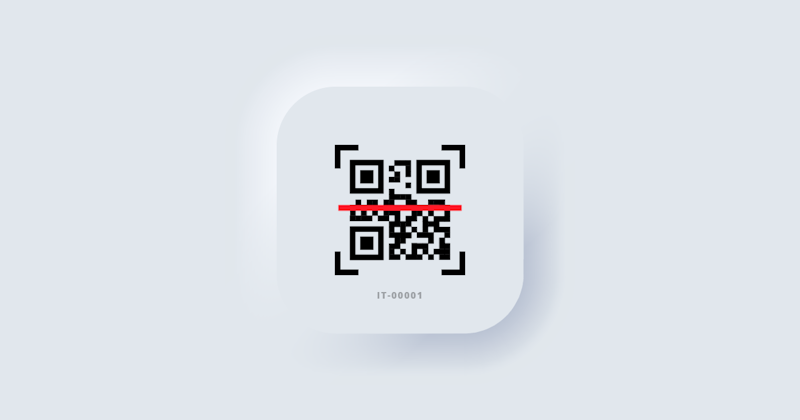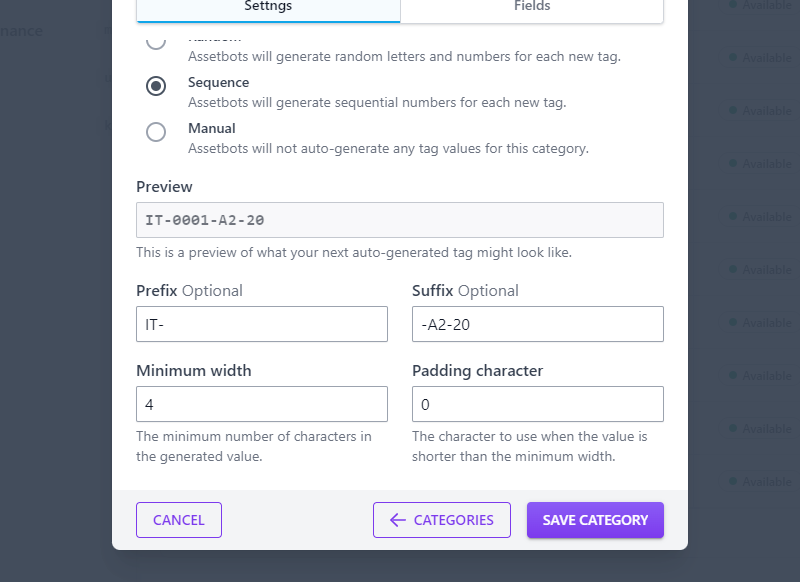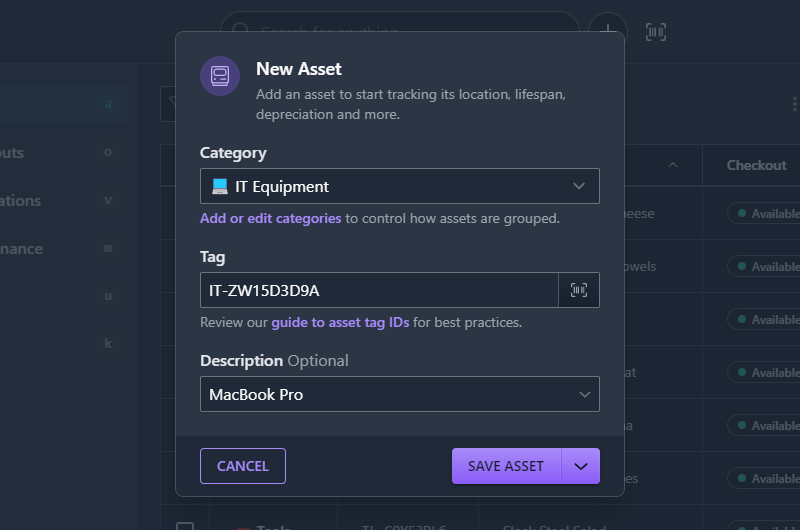
Asset Tagging Best Practices: What do you put on an asset tag?
Assetbots Team
Let’s assume you are just beginning the process of implementing a system to track your fixed assets. Before you can begin, you must decide on a consistent naming convention. Whether you have ten assets or ten thousand assets, each asset will need to be assigned a unique digital name so that it can be accurately identified and tracked. Without uniquely named assets, your asset tracking process will be inefficient and weak. A strong asset tracking process is essential to maintaining your assets’ value and lifespan, as well as preventing your organization from losing them.
This article discusses different asset tagging formats, standards, and best practices. You will learn about the advantages and disadvantages of using random, sequential and category-based naming conventions. You will also learn about some of the general pitfalls to avoid when naming your assets (and there are some big ones). There are many ways to go about assigning unique names to your assets. The best option for you will depend on the needs of your organization, and what works for your users and stakeholders.
What is an Asset Naming Convention?
An asset naming convention defines how each asset will be referenced in the system you have chosen to manage your assets (for example, asset tracking software). Each asset will eventually be tagged with its unique asset name. Ideally, an asset naming convention should consist of two parts: (1) a unique asset number, and (2) a descriptive name. In general, it should be standardized and inform stakeholders about the asset type and category. Asset naming conventions are important because they eliminate vagueness and ambiguity about each asset that is being managed. With a unique asset name, you will be able to easily and efficiently track a physical asset as it moves from place to place and person to person.
Best Practices for Naming Fixed Assets
Before we get into the different options for naming assets, here are some best practices to keep in mind:
- Avoid using non-alphanumeric characters (i.e. punctuation marks, symbols, special characters) in the asset names.
- Avoid using duplicate names, and strive to create a system where no duplicate names are possible.
- Keep names as short and meaningful as possible. Names on asset tags should only include information that is useful at a glance. Avoid adding too much detail.
- Create a logical structure so that employees can easily identify an asset by its asset label.
- Use a consistent number of characters for your unique identifier and any prefixes and suffixes. For example, instead of calling assets 1, 23, and 200, call them 001, 023, 200.
- Use consistent abbreviations and terms. Use abbreviations and acronyms that are easy to understand and will make sense to everyone.
- Observe hierarchies. Build your naming conventions in a top to bottom hierarchy, so that the prefix is the top element.
- Create a naming system that can grow with you as your organization acquires more assets. It is very cumbersome to change naming systems later on.
Different Types of Asset Naming Conventions
Random Naming
The most simple and straightforward asset naming convention is random naming. A random naming convention involves assigning each asset a name consisting of a randomized combination of letters and numbers. Using a combination of letters and numbers will decrease the likelihood of duplicate names being generated. For consistency, you should have all asset names contain the same number of characters. Using an asset tracking system that provides random naming can help you easily generate a random name for each asset you add to the system. For example, Assetbots can generate a random name as soon as you input the asset:

One benefit of using a random naming convention is that it is hard to outgrow. As your organization acquires more and more assets, a random naming convention can easily accommodate that growth. However, random numbers don’t in themselves reveal any descriptive information about the asset, which could be problematic if you have many different types of assets to track or need to quickly understand certain information about an asset without referring to your asset database. This issue could be resolved by adding descriptive prefixes or suffixes to your asset name as explained in the Category-Based Naming section below.
Sequential Naming
Sequential naming typically uses a numerical sequence or counter that increases by one with each additional asset. To use this method, you must first estimate how many assets you currently have and how many your organization may acquire in the future. If, for example, your organization has 1,000 assets today but is quickly growing in size, you will want to set a sequential naming convention that can accommodate not only what you have today but also what you will have five years from now.
Let’s assume that you expect your organization’s assets to double in size in five years. In this scenario, you will want to pick a sequence that has at least four digits. The first five assets will be numbered like this:

The last five assets will be numbered like this:

Each asset number will increment by one, with zeros added in front of the number as padding when needed to keep the character count consistent.
One downside of using a sequential naming convention is that your organization could outgrow it if you underestimate the amount of assets you will own in the future. Also, sequential numbers don’t in themselves reveal any descriptive information about the asset other than its relative age. For example, you might know that assets numbered below a certain number (i.e. under 50) are at or nearing end-of-life. If you want to add additional descriptive information about an asset, you can add descriptive prefixes or suffixes to a sequential asset number as explained below.
Category-Based Naming
A category-based naming convention can be created to meet the specific tracking requirements of your organization. For example, you could design it to include the descriptive information that is most important to you about each asset, such as the category or type of asset, where the asset lives, who is responsible for the asset, and the year of purchase of the asset. Basically, a category-based naming convention involves adding prefixes or suffixes to a random or sequential naming convention.
By using a category-based naming convention, you will be able to glean important information about the asset by simply viewing its asset tag. This could be useful if you don’t have immediate access to your asset database and need to quickly understand certain information about an asset.
Below is a list of suggested descriptive information you could include:
- Asset category: IT equipment, audio-visual equipment, vehicle, furniture, etc.
- Asset type: printer, server, laptop, tablet, monitor, chair, truck.
- Characteristic: make, manufacturer, model, revision, size, color, year of purchase, etc.
- Location: building name, country, state, address, floor/level number, room number, shelf, etc.
- Numbers: VIN number, manufacturer serial number, etc.
- Ownership: owner user, department, organization unit, cost center.
For example, let’s say that your organization is a school that is tracking iPads that are being used by students throughout the campus. You have decided that you want to encode information about the asset category, asset location, and year of purchase in the asset name. Accordingly, you decide to add a prefix showing the asset category, and suffixes showing the location and year of purchase. You decide that the asset’s unique identifier will be determined using sequential naming. Here is an example of an asset name that your organization might use:
IT-0345-A2-20
IT: The first part of this asset name tells you that the asset being tracked is IT equipment. In this example, IT is the abbreviation your organization has chosen to identify such category.
0345: The second part of the asset name is the asset’s unique identifier, which could either be sequential or randomized alphanumeric characters.
A2: The third part of the asset name tells you that the asset resides in Room A2. In this example, A2 is the abbreviation your organization has chosen to name one of its locations.
20: The fourth part of the asset name tells you that the asset was purchased in 2020.
As you see from the sample asset name above, you can encode information about the asset into the asset’s name by adding prefixes and suffixes to the asset’s unique identifier, and by using separators such as a dash to separate each part of the asset name. With a category-based naming convention, the sky is the limit with how customized you would like to get. Your asset tracking software might allow you to set up prefixes and suffixes for your asset categories and have them applied automatically:

If you are using a category-based naming convention, make sure to be consistent in the terminology, abbreviations, and numbering schemes that you use. Also, use the same number of digits for all numbering schemes and be sure to leave room for growth so that new assets can be added easily in the future.
Other Considerations for Picking an Asset Naming Convention
Does your organization already use an asset naming convention?
Before you begin the process of choosing a naming system, you should determine whether your organization already has a naming system for fixed assets. Different departments may be tracking assets for different reasons. For example, your accounting department might have already named assets for the purpose of tracking their purchase price, depreciation, and maintenance costs.
If there is an asset naming convention being used, you should consider whether to adopt it so that it can be used universally throughout the organization. One benefit of consistency is better cross-departmental communication about assets. Also, as more departments take advantage of your asset database for their needs, the database becomes more valuable and is able to provide better reporting.
However, even if your organization already has a naming convention, it might be beneficial to create a new one if the current one is not efficient or does not translate easily across different departments.
Advantages of creating your own asset naming convention
Creating your own asset naming convention has several advantages for your organization. Specifically, you can create an asset naming convention that caters to your needs and tracks the information that is most important to you. For example, if your organization is tracking a wide variety of assets, such as vehicles, tools, and IT equipment, it might be useful to use a category-based naming scheme so that you can include the category or type of asset in the asset name. If your organization is tracking only one type of asset, such as vehicles, it would not make sense to include this descriptive information in the asset name, and a sequential or random naming system might suffice.
Does your organization have several different locations where your assets are housed? Then your organization may want to incorporate descriptive information identifying a location into an asset naming convention. For example, if you are a facilities management organization or a school with multiple campuses, it might be important to include the asset’s location in its name. On the other hand, if you are tracking assets that are constantly on the move, such as a fleet of vehicles, it would not make sense to include location information in the asset name.
In creating an asset naming convention, you should consider the type and amount of assets you own, and your organization’s future plans for acquiring more assets so that you can pick an asset naming convention that can grow to meet your organization’s needs.
Conclusion
Taking the time to figure out the best naming convention for your organization will ultimately serve you well. Doing it right the first time will save your employees’ time in tracking and managing your fixed assets for years to come.
With a clear and efficient asset naming convention:
- Your employees and technicians will be able to easily identify and differentiate between assets.
- You will be able to refer to an asset by its asset name instead of by a lengthy description of the asset, making communication more efficient and clear.
- You will be able to easily name and add new assets during data entry.
- You will be able to quickly locate existing assets in your asset database, saving your employees’ valuable time in tracking down assets and deterring theft and loss.



